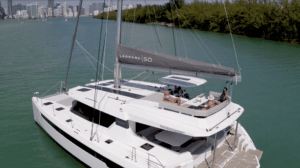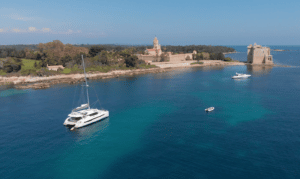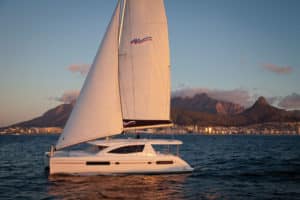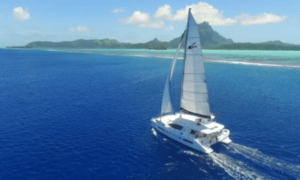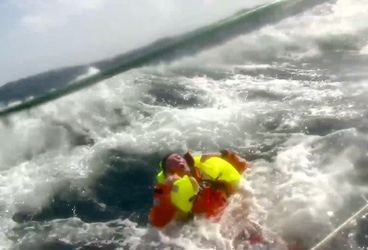
Following Derry~Londonderry~Doire’s dramatic North Pacific rescue operation yesterday, Clipper Race round the world crew member Andrew Taylor is making a good recovery, with Skipper Sean McCarter explaining:
After a dramatic day yesterday I am both happy and relieved to report that all the crew are healthy and in good spirits.
Yesterday morning the breeze was easing off after a fairly heavy night and we decided to unhank the Yankee 2 from the foredeck and hank on the Yankee 3 in its place, then pole out.
I was unhanking and round the world crew member Andrew Taylor was assisting. We needed a pair of pliers and Andrew was preparing to go back when we managed to free the offending hank and continue on with our work.
Suddenly the boat leaned heavily to leeward and I watched Andrew in slow motion slide out over the top of the Yankee 2 and guard rail and into the sea.
Assuming he was clipped on, I shouted to helm, round the world crew member, Kristi Wilson to stop the boat by bringing it around into the then 35 knots of wind. I made my way back to the helm as quickly as I could giving the ‘Man Overboard’ shout as I went. I was shocked to see one of the crew pointing behind us and calling distance to the MOB.
Andrew hadn’t been clipped on. We can only guess that somewhere between going to get the pliers then not needing them, he got distracted and forgot to clip on again.
The crew reacted perfectly, nobody panicked, everyone went through the procedures that we practice religiously in Clipper Race training. The MOB button was pressed giving us the position on the electronic chart plotter, the engine was started, boat checked for ropes in the water and staysail dropped all within minutes.
At this stage we were getting blown away from Andrew slowly but at a range of about 200 metres we still had visual contact. Getting the boat to go through the wind and over the 4 to 6 metre seas was a struggle for the engine even at full RPM, but we managed it.
I asked for a heading to the casualty and got the reply I dreaded most; ‘We’ve lost visual’. All of a sudden the North Pacific became a very big place.
We began making our way back along our track and arrived at the MOB charted position and continued past it without any sign of Andrew. The waves were the size of bungalows and the wind was whipping up spray off the crests with streams of foam running down the faces.
We put Kristi Wilson up to the first spreader for a better view and had round the world crew member Conor O’Byrne who is also an ex-RNLI mechanic initiate search patterns. We guessed Andrew’s rate and direction of drift and searched accordingly.
We put out a MAYDAY and were relieved to get a response from Olly Cotterell on OneDLL. They were just under two hours from us and began making best speed into the wind and sea to help us with the search.
Watch the recovery effort in this video:
About half an hour after Andrew went into the water, a massive black cloud approached bringing gusts into the 50s, hail-stones and reducing visibility to a matter of metres. After about ten minutes, the cloud passed and visibility improved somewhat. We continued our search going further and further downwind of the MOB position and short-tacking our way up the probable drift line but to no avail.
Andrew had been in the 11 degree water over an hour at this stage. He was wearing a dry-suit but would still be going hypothermic at this point if he hadn’t been already. Although no one was saying it, everyone was starting to fear the worst.
No sooner had these thoughts began creeping in than Conor O’Byrne shouted up from the Navigation station that Andrew’s Personal Locator beacon had just activated.
He gave us a course to steer and a distance of over 1 mile from our position. We made best speed to the position but took longer than I expected. Andrew’s beacon then explained it; he was drifting at up to 4 knots where we had been expecting him to be doing 1 to 2 knots max.
Kristi spotted Andrew first from her position aloft. She put him at about 400 metres.
It took another 30 seconds before we could see him at about 200 metres in the mountainous seas.
At first I had a huge sense of relief. This was quickly followed thoughts of Andrew’s condition; what if he was unconscious or worse. As we approached, Andrew began waving his arms and shouting.
Relief.
It took us two attempts but in the end, Andrew practically pulled himself onboard! He was stretchered below efficiently just as we practice in training and cut out of his dry-suit much to his dismay. He was rotated through as many dry sleeping bags as we could muster, all of which were stuffed with warm water bottles to slowly bring up his body temperature.
Over 24 hours later, Andrew is in good form, chatting readily about his experience with myself and the crew. He got a bang on his leg by the rudder which we hope isn’t too serious but all in all is very happy.
Andrew recounts his experience while warming up in this video. Warning: some expletives.
Our heartfelt thanks goes out to skipper Olly Cotterell and his crew on OneDLL for coming to our assistance. Luckily we were picking Andrew up just as they came on the scene but had Andrew’s personal locator not activated, a second boat in the search would have been invaluable.
Thanks also to Deputy Race Director Mark Light and Falmouth Search and Rescue who were both in contact allowing us to continue with the search.
There are three main factors that contributed to Andrew’s survival. First was the rigorous training that both skipper and crew go through with the Clipper Race in the UK before starting the race.
Everyone knew exactly what had to be done and went about it in a calm and controlled manner. Second was Andrew’s Henri Lloyd drysuit, without which he could not have survived for what ended up being 1 hour 40minutes in the cold water of the North Pacific. Finally his Personal Locator Beacon, without which the already long search would have taken a lot longer.
Following what has been learnt so far about the incident, Clipper Race chairman Sir Robin Knox-Johnston has sent a personal message to the boats to remind them of their safety training, in which he stated: “This is a reminder of two basic points from your training. Always clip on, and check that you are clipped on by pulling on the tether to ensure it is fast before going further…Human life is far too precious to be thrown away by a moment’s forgetfulness.
The Clipper Round the World Yacht Race
The Clipper 13-14 Round the World Yacht Race started Sunday, 1 September from St Katharine Docks London, and will return almost a year later after completing the 40,000 miles route, making it the world’s longest ocean race.
The event was established in 1995 by Sir Robin Knox-Johnston to give everyone, regardless of sailing experience, the opportunity to discover the exhilaration of ocean racing. 670 people representing more than 40 nations will compete in the Clipper 13-14 Race on twelve brand new 70-foot yachts designed by renowned naval architect Tony Castro.

